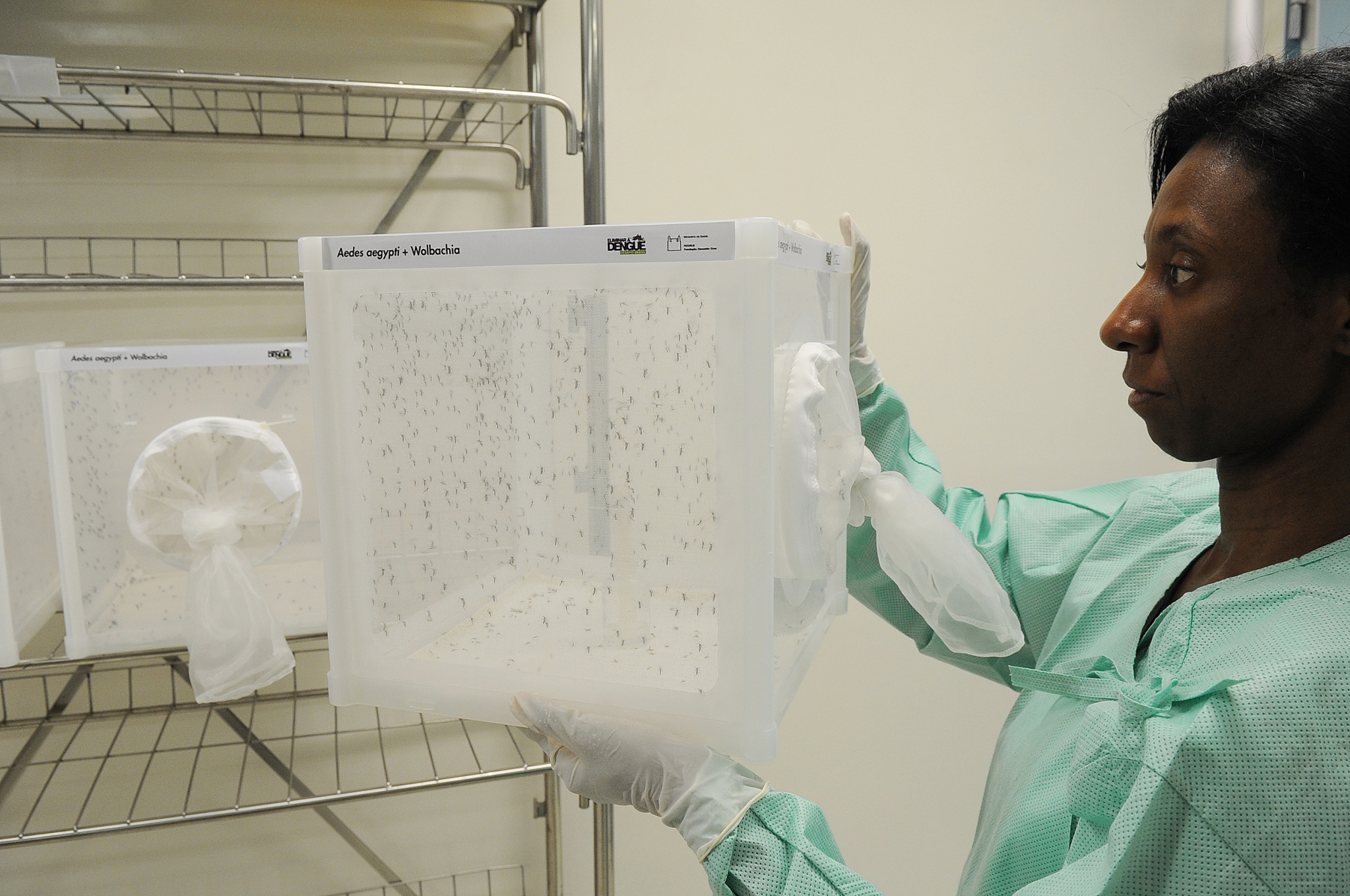Are Altered Mosquitoes a Public Health Project, or a Business?

The fight against dengue and Zika in Latin America is turning into a contest between mosquito-altering technologies, and between profits and public health.
On Wednesday, Eliminate Dengue, a nonprofit based in Australia, said it had received $18 million from the U.S. government and other donors to rapidly launch citywide releases in Rio de Janeiro and in a suburb of Medellin, Colombia, of mosquitoes infected with a bacteria that makes the species Aedes aegypti unable to transmit the two viruses.
The scope of these Latin tests has leaped ahead of for-profit efforts by Oxitec, which has field-tested genetically modified mosquitoes in Brazil, the Cayman Islands, and Florida.
The contrasting efforts show how public health organizations, and some governments, are betting heavily on modifications that could be exceptionally cheap because they actually spread among mosquitoes as they reproduce, in effect dispersing an antidote far and wide from the point of release.
Eliminate Dengue says that by releasing females infected with the bacterium, called Wolbachia, eventually all mosquitoes in an area will acquire the germ, effectively replacing local mosquitoes with ones that don’t spread disease. It says the cost of eliminating the viruses could be as low as $1 a person, after a campaign of releasing about a million mosquitoes in a year over several square kilometers.
Companies like Oxitec, on the other hand, also aim to interrupt the spread of Zika and dengue, but they do it in smaller areas using ongoing large-scale, weekly releases of millions of sterile male mosquitoes that can’t reproduce, can’t spread their traits, and don’t stick around.
Oxitec describes its technology as “self-limiting.” The males, made sterile because of a genetic alteration, cause mosquito populations—along with the bites from females that spread disease—to decline. But it’s also likely to be more expensive. Brazilian officials working on a test with Oxitec have cited a cost of $7.50 a year, per person, to protect them from bites using Oxitec’s mosquito releases. Sterile males are often released in numbers 100 times greater than the normal males present in an area.
“The sterile male requires ongoing releases; that is why it’s associated with commercial groups, because there’s a revenue stream, like applying insecticides,” says Scott O’Neill, the entomologist who heads Eliminate Dengue, which has been funded heavily by the Bill and Melinda Gates Foundation.
Public health organizations, including the Gates Foundation, are investing in another technology able to spread on its own, called a gene drive. That is a more speculative approach, using high-tech gene-editing methods, which can cause genetic modifications to spread quickly through wild mosquitoes, potentially blocking their ability to spread disease, or causing their numbers to decline.
But Gates has invested $75 million in the idea of combating malaria, and this week the Tata Trusts of Mumbai, which controls India’s Tata industrial conglomerate, gave $70 million to the University of California, San Diego, for similar research and to train Indian scientists.
Fil Randazzo, an official with the Gates Foundation, which has already invested more than $100 million in Eliminate Dengue and its gene-drive program, Target Malaria, said in an interview earlier this year that the organization was intentionally funding self-spreading technology because it would prove cheaper to implement.
With gene drives, releasing just a few hundred mosquitoes could spread the alteration over vast areas.
“I don’t believe that there is really a business model in a self-sustaining technology for public health,” Randazzo said. “I can’t see how there would be profit in releasing a few times and then you are done.”
For companies, investing millions in technology that might be used just once doesn’t make sense. What’s more, creating permanent changes to the environment raises difficult new regulatory questions, says Hadyn Parry, CEO of Oxitec. “We work purely on our self-limiting system that does not perpetuate in the environment,” Parry said in an e-mail.
Parry said that because of the unknowns, gene drives in particular “is not an area of commercial investment.”
In addition to Oxitec, Google’s health spin-off Verily recently announced plans to use sterile male insects to fight Zika and dengue. It also uses the Wolbachia bacterium, but exploits a different property of the germ, which is that males infected with it can’t reproduce with normal females.
Nigel Snoad, who manages “Project Debug” at Verily, says the Google spin-off believes that given the scope of the Zika problem in particular, many different techniques are needed. “We think mosquito suppression has a role, and that there is a lot of room to try different things,” says Snoad.
Verily is developing automated techniques for rearing large numbers of male mosquitoes. In typical Google fashion, the company is spending heavily on scaling up the technology without a clear commercial return in view. “We don’t know yet what the business model is,” says Snoad. “That’s to be determined.”
Keep Reading
Most Popular
Large language models can do jaw-dropping things. But nobody knows exactly why.
And that's a problem. Figuring it out is one of the biggest scientific puzzles of our time and a crucial step towards controlling more powerful future models.
How scientists traced a mysterious covid case back to six toilets
When wastewater surveillance turns into a hunt for a single infected individual, the ethics get tricky.
The problem with plug-in hybrids? Their drivers.
Plug-in hybrids are often sold as a transition to EVs, but new data from Europe shows we’re still underestimating the emissions they produce.
Stay connected
Get the latest updates from
MIT Technology Review
Discover special offers, top stories, upcoming events, and more.